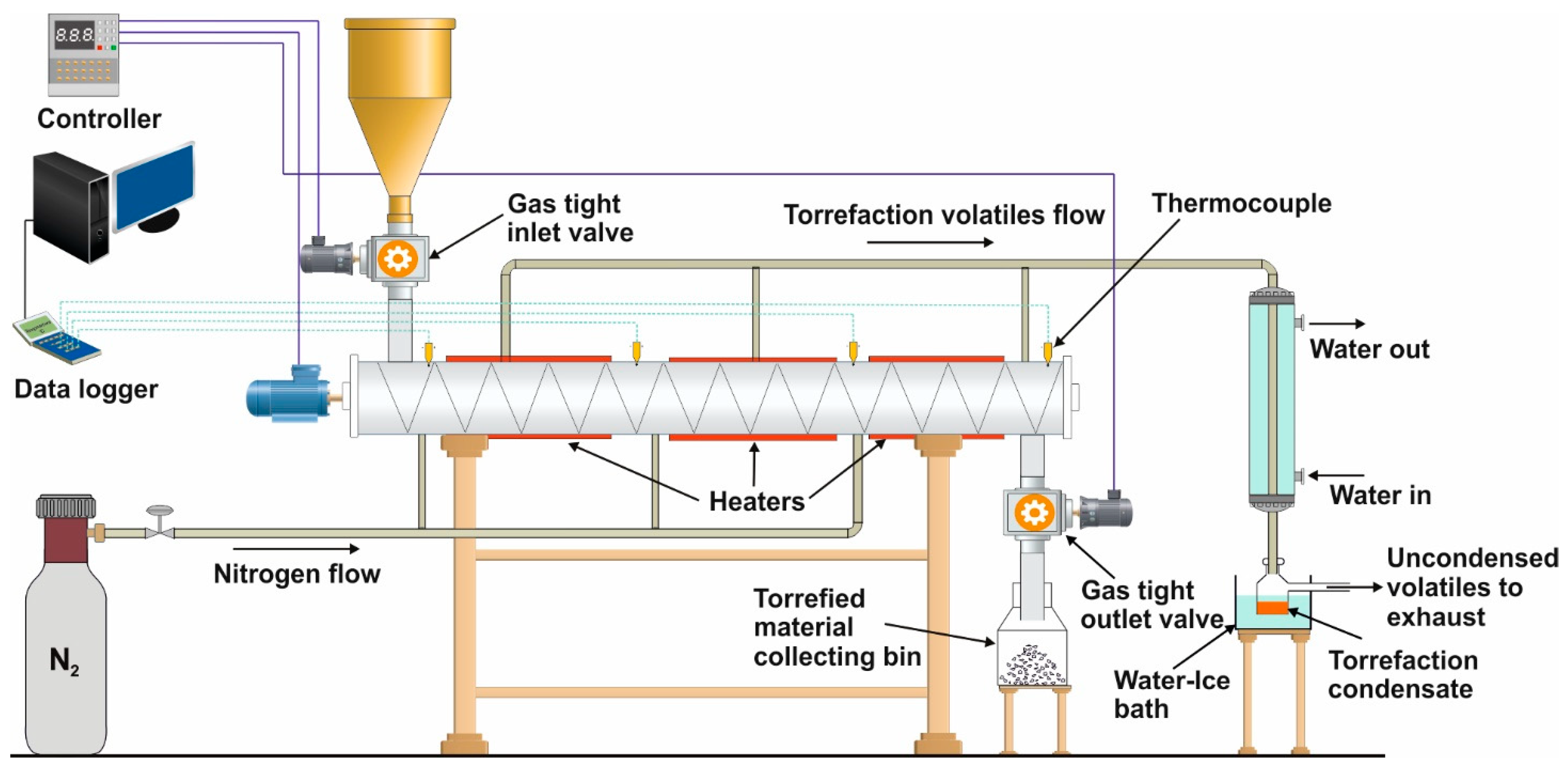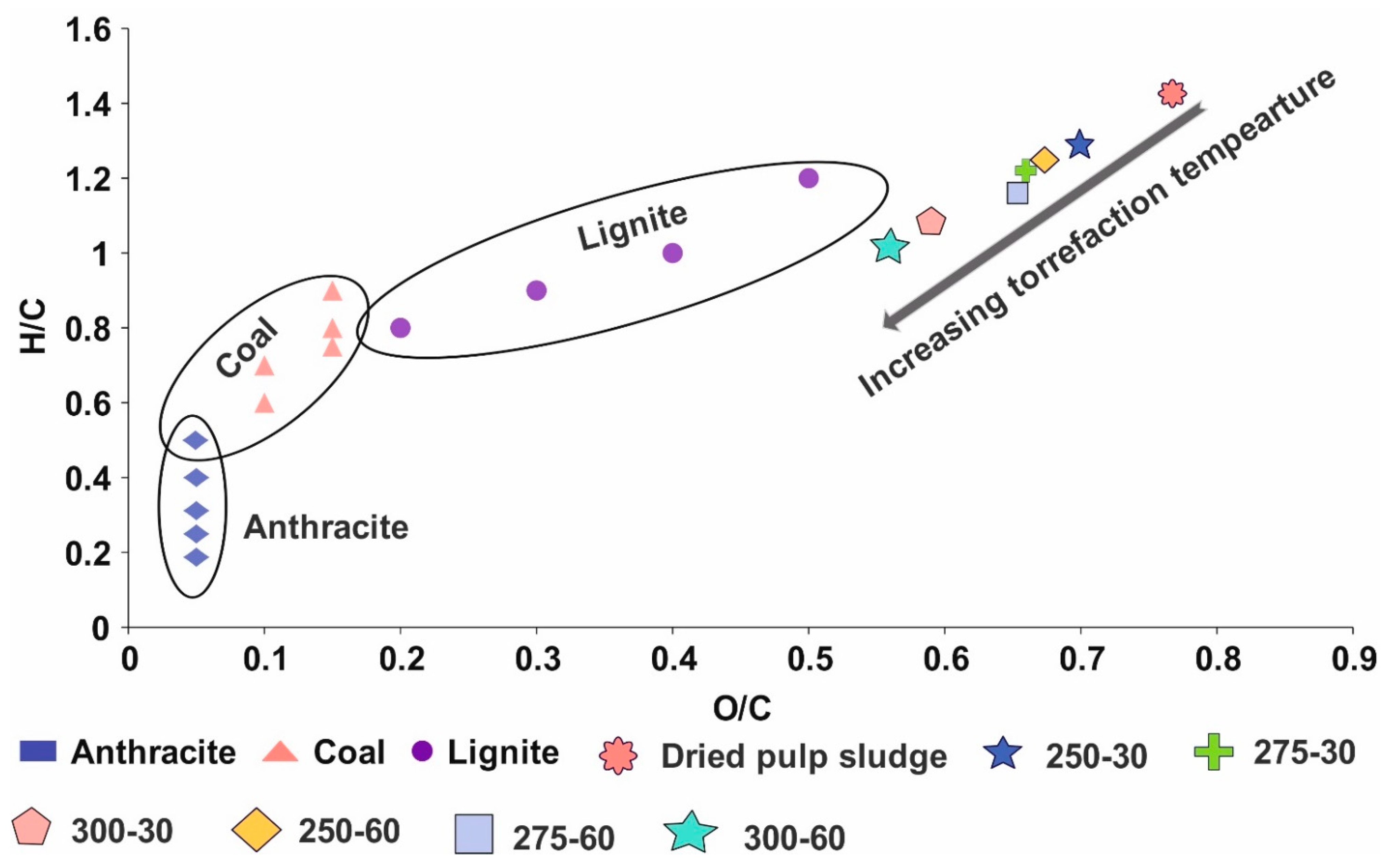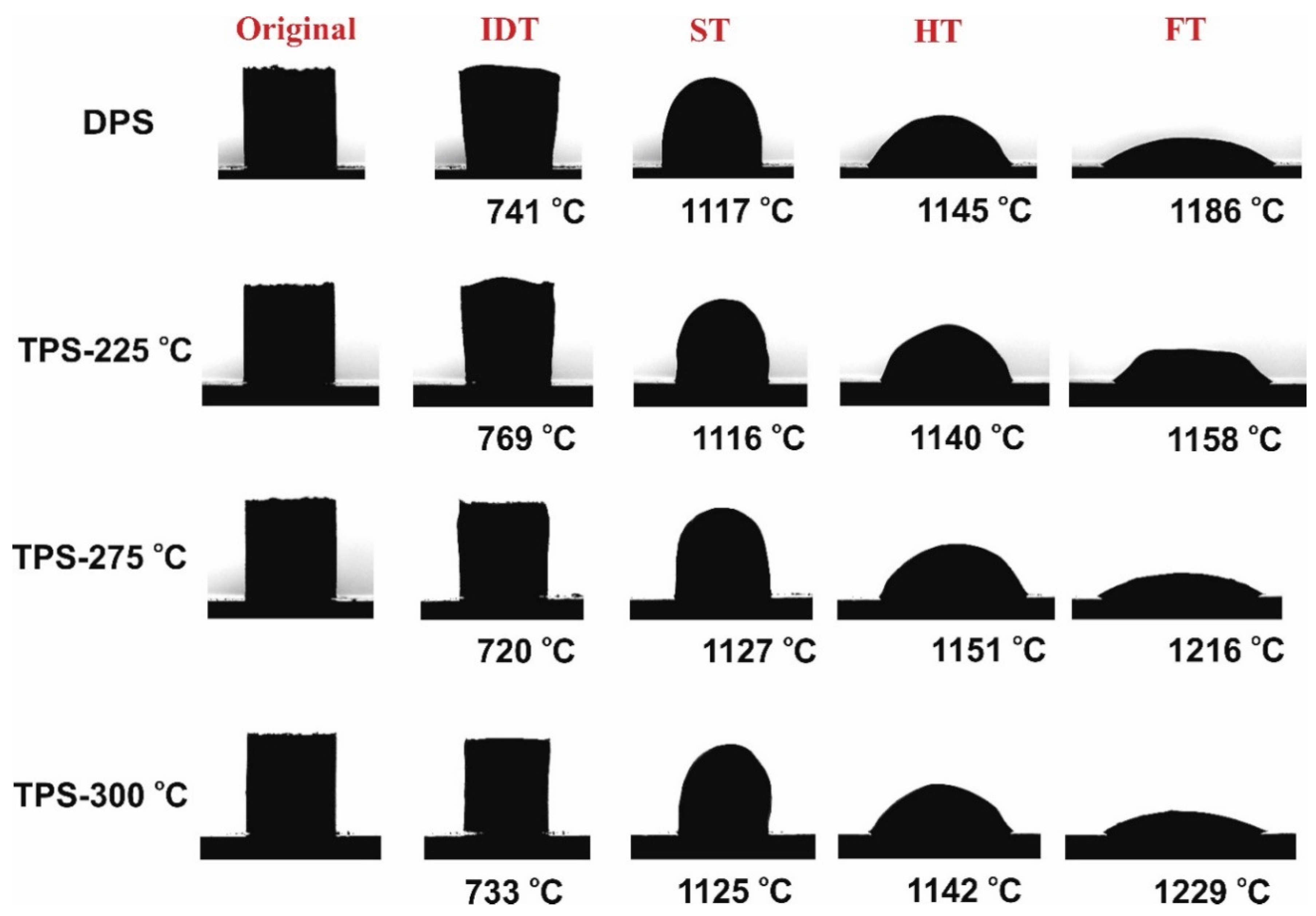Torrefaction of Pulp Industry Sludge to Enhance Its Fuel Characteristics
Abstract
1. Introduction
2. Materials and Methods
2.1. Pulp Sludge
2.2. Torrefaction Experiments
2.3. Analytical Methods
2.3.1. Heating Value
2.3.2. Proximate and Ultimate Analysis
2.3.3. Composition Analysis
2.3.4. Ash Composition and Ash Melting Behavior
3. Results
3.1. Mass and Energy Yield
3.2. Ultimate Analysis and Proximate Analysis
3.3. Energy Content
3.4. Fuel Ratio
3.5. Ash Composition and Ash Melting Behavior
3.5.1. Ash Composition
3.5.2. Ash Melting Behavior
3.6. Chemical Composition Analysis
4. Summary
5. Conclusions
Author Contributions
Funding
Data Availability Statement
Acknowledgments
Conflicts of Interest
References
- NASA. Climate Change: How Do We Know? Available online: https://climate.nasa.gov/evidence/ (accessed on 10 March 2022).
- Shamoon, A.; Haleem, A.; Bahl, S.; Javaid, M.; Bala Garg, S. Role of energy technologies in response to climate change. Mater. Today Proc. 2022, 62, 63–69. [Google Scholar] [CrossRef]
- IEA. Key World Energy Statistics 2021; IEA: Paris, France, 2021. [Google Scholar]
- IEA. Coal 2021; IEA: Paris, France, 2021. [Google Scholar]
- Cahyanti, M.N.; Doddapaneni, T.R.K.C.; Kikas, T. Biomass torrefaction: An overview on process parameters, economic and environmental aspects and recent advancements. Bioresour. Technol. 2020, 301, 122737. [Google Scholar] [CrossRef] [PubMed]
- Doddapaneni, T.R.K.C.; Praveenkumar, R.; Tolvanen, H.; Palmroth, M.R.T.; Konttinen, J.; Rintala, J. Anaerobic batch conversion of pine wood torrefaction condensate. Bioresour. Technol. 2017, 225, 299–307. [Google Scholar] [CrossRef] [PubMed]
- Doddapaneni, T.R.K.C.; Praveenkumar, R.; Tolvanen, H.; Rintala, J.; Konttinen, J. Techno-economic evaluation of integrating torrefaction with anaerobic digestion. Appl. Energy 2018, 213, 272–284. [Google Scholar] [CrossRef]
- Bajpai, P. Generation of Waste in Pulp and Paper Mills. In Management of Pulp and Paper Mill Waste; Springer International Publishing: Cham, Switzerland, 2015; pp. 9–17. [Google Scholar] [CrossRef]
- Kaur, R.; Tyagi, R.D.; Zhang, X. Review on pulp and paper activated sludge pretreatment, inhibitory effects and detoxification strategies for biovalorization. Environ. Res. 2020, 182, 109094. [Google Scholar] [CrossRef]
- Monte, M.C.; Fuente, E.; Blanco, A.; Negro, C. Waste management from pulp and paper production in the European Union. Waste Manag. 2009, 29, 293–308. [Google Scholar] [CrossRef]
- Mendoza Martinez, C.L.; Sermyagina, E.; Vakkilainen, E. Hydrothermal Carbonization of Chemical and Biological Pulp Mill Sludges. Energies 2021, 14, 5693. [Google Scholar] [CrossRef]
- Liu, Z.; Hughes, M.; Tong, Y.; Zhou, J.; Kreutter, W.; Lopez, H.C.; Singer, S.; Zitomer, D.; McNamara, P. Paper mill sludge biochar to enhance energy recovery from pyrolysis: A comprehensive evaluation and comparison. Energy 2022, 239, 121925. [Google Scholar] [CrossRef]
- Tarelho, L.A.C.; Hauschild, T.; Vilas-Boas, A.C.M.; Silva, D.F.R.; Matos, M.A.A. Biochar from pyrolysis of biological sludge from wastewater treatment. Energy Rep. 2020, 6, 757–763. [Google Scholar] [CrossRef]
- Grimm, A.; Etula, J.; Salh, R.; Kalén, G.; Segerström, M.; Brücher, J.; Söderberg, C.; Soukup, D.; Pfeifer, C.; Larsson, S.H. Slagging and fouling characteristics during co-combustion of Scots pine bark with low-temperature dried pulp and paper mill chemical sludge. Fuel Process. Technol. 2019, 193, 282–294. [Google Scholar] [CrossRef]
- Latva-Somppi, J. Experimental Studies on Pulp and Paper Mill Sludge Ash Behavior in Fluidized Bed Combustors; VTT Publication 336; Technical Research Centre of Finland: Espoo, Finland, 1998; pp. 1–89. [Google Scholar]
- Huang, M.; Chang, C.-C.; Yuan, M.-H.; Chang, C.-Y.; Wu, C.-H.; Shie, J.-L.; Chen, Y.-H.; Chen, Y.-H.; Ho, C.; Chang, W.-R.; et al. Production of torrefied solid bio-fuel from pulp industrywaste. Energies 2017, 10, 910. [Google Scholar] [CrossRef]
- Cahyanti, M.N.; Doddapaneni, T.R.K.C.; Madissoo, M.; Pärn, L.; Virro, I.; Kikas, T. Torrefaction of Agricultural and Wood Waste: Comparative Analysis of Selected Fuel Characteristics. Energies 2021, 14, 2774. [Google Scholar] [CrossRef]
- Phanphanich, M.; Mani, S. Impact of torrefaction on the grindability and fuel characteristics of forest biomass. Bioresour. Technol. 2011, 102, 1246–1253. [Google Scholar] [CrossRef] [PubMed]
- Lachman, J.; Baláš, M.; Lisý, M.; Lisá, H.; Milčák, P.; Elbl, P. An overview of slagging and fouling indicators and their applicability to biomass fuels. Fuel Process. Technol. 2021, 217, 106804. [Google Scholar] [CrossRef]
- Garcia-Maraver, A.; Mata-Sanchez, J.; Carpio, M.; Perez-Jimenez, J.A. Critical review of predictive coefficients for biomass ash deposition tendency. J. Energy Inst. 2017, 90, 214–228. [Google Scholar] [CrossRef]
- Barta-Rajnai, E.; Wang, L.; Sebestyén, Z.; Barta, Z.; Khalil, R.; Skreiberg, Ø.; Grønli, M.; Jakab, E.; Czégény, Z. Effect of Temperature and Duration of Torrefaction on the Thermal Behavior of Stem Wood, Bark, and Stump of Spruce. Energy Procedia 2017, 105, 551–556. [Google Scholar] [CrossRef]
- Gucho, E.M.; Shahzad, K.; Bramer, E.A.; Akhtar, N.A.; Brem, G. Experimental study on dry torrefaction of beech wood and miscanthus. Energies 2015, 8, 3903–3923. [Google Scholar] [CrossRef]
- Lin, Y.L.; Zheng, N.Y.; Wang, H.C. Sludge dewatering through H2O2 lysis and ultrasonication and recycle for energy by torrefaction to achieve zero waste: An environmental and economical friendly technology. Renew. Sustain. Energy Rev. 2022, 155, 111857. [Google Scholar] [CrossRef]
- Zhang, S.; Su, Y.; Ding, K.; Zhu, S.; Zhang, H.; Liu, X.; Xiang, Y. Effect of inorganic species on torrefaction process and product properties of rice husk. Bioresour. Technol. 2018, 265, 450–455. [Google Scholar] [CrossRef]
- Ma, Z.; Zhang, Y.; Shen, Y.; Wang, J.; Yang, Y.; Zhang, W.; Wang, W. Oxygen migration characteristics during bamboo torrefaction process based on the properties of torrefied solid, gaseous, and liquid products. Biomass Bioenergy 2019, 128, 105300. [Google Scholar] [CrossRef]
- Reddy, P.J. Clean Coal Technologies for Power Generation; Taylor & Francis: Abingdon, UK, 2013. [Google Scholar]
- Markič, M.; Kalan, Z.; Pezdič, J.; Faganeli, J. H/C versus O/C atomic ratio characterization of selected coals in Slovenia. Geologija 2007, 50, 403–426. [Google Scholar] [CrossRef]
- Orem, W.H.; Finkelman, R.B. Coal Formation and Geochemistry. In Treatise on Geochemistry; Holland, H.D., Turekian, K.K., Eds.; Elsevier: Oxford, UK, 2003; pp. 191–222. [Google Scholar] [CrossRef]
- Pitak, L.; Laloon, K.; Wongpichet, S.; Sirisomboon, P.; Posom, J. Machine learning-based prediction of selected parameters of commercial biomass pellets using line scan near infrared-hyperspectral image. Processes 2021, 9, 316. [Google Scholar] [CrossRef]
- Ibitoye, S.E.; Jen, T.C.; Mahamood, R.M.; Akinlabi, E.T. Improving the combustion properties of corncob biomass via torrefaction for solid fuel applications. J. Compos. Sci. 2021, 5, 260. [Google Scholar] [CrossRef]
- Sarker, T.R.; Azargohar, R.; Dalai, A.K.; Meda, V. Enhancement of fuel and physicochemical properties of canola residues via microwave torrefaction. Energy Rep. 2021, 7, 6338–6353. [Google Scholar] [CrossRef]
- Huang, Y.F.; Cheng, P.H.; Chiueh, P.T.; Lo, S.L. Microwave Torrefaction of leucaena to Produce Biochar with High Fuel Ratio and Energy Return on Investment. Energy Procedia 2017, 105, 35–40. [Google Scholar] [CrossRef]
- Xie, K.-C. Chemical Characteristics of Coal. In Structure and Reactivity of Coal; Springer: Berlin/Heidelberg, Germany, 2015; pp. 67–117. [Google Scholar] [CrossRef]
- Berruti, F.; Wong, R. Strategies for Low Emissions from Circulating Fluidized Bed Boilers. In Chemical Reactor Technology for Environmentally Safe Reactors and Products; De Lasa, H.I., Doğu, G., Ravella, A., Eds.; Springer: Dordrecht, The Netherlands, 1992; pp. 379–408. [Google Scholar] [CrossRef]
- Budzyń, S.; Tora, B. Biomass fuel based on wastes from the paper industry. In Proceedings of the 1st International Conference on the Sustainable Energy and Environment Development (SEED 2016), Kraków, Poland, 17–19 May 2016. [Google Scholar] [CrossRef]
- Wang, S.; Wen, Y.; Hammarström, H.; Jönsson, P.G.; Yang, W. Pyrolysis behaviour, kinetics and thermodynamic data of hydrothermal carbonization–Treated pulp and paper mill sludge. Renew. Energy 2021, 177, 1282–1292. [Google Scholar] [CrossRef]
- Coimbra, R.N.; Paniagua, S.; Escapa, C.; Calvo, L.F.; Otero, M. Thermal Valorization of Pulp Mill Sludge by Co-processing with Coal. Waste Biomass Valorization 2016, 7, 995–1006. [Google Scholar] [CrossRef]
- Simão, L.; Jiusti, J.; Lóh, N.J.; Hotza, D.; Raupp-Pereira, F.; Labrincha, J.A.; Montedo, O.R.K. Waste-containing clinkers: Valorization of alternative mineral sources from pulp and paper mills. Process. Saf. Environ. Prot. 2017, 109, 106–116. [Google Scholar] [CrossRef]
- Mitikie, B.B.; Waldtsadik, D.T. Partial Replacement of Cement by Waste Paper Pulp Ash and Its Effect on Concrete Properties. Adv. Civ. Eng. 2022, 2022, 8880196. [Google Scholar] [CrossRef]
- Teng, T.T.; San Wong, S.; Wei Low, L. Coagulation–Flocculation Method for the Treatment of Pulp and Paper Mill Wastewater. In The Role of Colloidal Systems in Environmental Protection; Fanun, M.P., Ed.; Elsevier: Amsterdam, The Netherland, 2014; pp. 239–259. [Google Scholar] [CrossRef]
- Niu, Y.; Tan, H.; Wang, X.; Liu, Z.; Liu, H.; Liu, Y.; Xu, L. Study on fusion characteristics of biomass ash. Bioresour. Technol. 2010, 101, 9373–9781. [Google Scholar] [CrossRef]
- Wang, Q.; Han, K.; Gao, J.; Wang, J.; Lu, C. Investigation of Maize Straw Char Briquette Ash Fusion Characteristics and the Influence of Phosphorus Additives. Energy Fuels 2017, 31, 2822–2830. [Google Scholar] [CrossRef]
- Adeleke, A.A.; Odusote, J.K.; Ikubanni, P.P.; Lasode, O.A.; Malathi, M.; Paswan, D. The ignitability, fuel ratio and ash fusion temperatures of torrefied woody biomass. Heliyon 2020, 6, e03582. [Google Scholar] [CrossRef] [PubMed]
- Muizniece, I.; Klavina, K. Logging Residue Fuel Characteristic Ash Melting Temperatures. Energy Procedia 2016, 95, 314–318. [Google Scholar] [CrossRef][Green Version]
- Niu, Y.; Lv, Y.; Zhang, X.; Wang, D.; Li, P.; Hui, S. Effects of water leaching (simulated rainfall) and additives (KOH, KCl, and SiO2) on the ash fusion characteristics of corn straw. Appl. Therm. Eng. 2019, 154, 485–492. [Google Scholar] [CrossRef]
- Kopczyński, M.; Lasek, J.A.; Iluk, A.; Zuwała, J. The co-combustion of hard coal with raw and torrefied biomasses (willow (Salix viminalis), olive oil residue and waste wood from furniture manufacturing). Energy 2017, 140, 1316–1325. [Google Scholar] [CrossRef]
- Alam, M.T.; Dai, B.; Wu, X.; Hoadley, A.; Zhang, L. A critical review of ash slagging mechanisms and viscosity measurement for low-rank coal and bio-slags. Front. Energy 2021, 15, 46–67. [Google Scholar] [CrossRef]
- Niu, Y.; Tan, H.; Hui, S. Ash-related issues during biomass combustion: Alkali-induced slagging, silicate melt-induced slagging (ash fusion), agglomeration, corrosion, ash utilization, and related countermeasures. Prog. Energy Combust. Sci. 2016, 52, 1–61. [Google Scholar] [CrossRef]
- Deeba, F.; Pruthi, V.; Negi, Y.S. Converting paper mill sludge into neutral lipids by oleaginous yeast Cryptococcus vishniaccii for biodiesel production. Bioresour. Technol. 2016, 213, 96–102. [Google Scholar] [CrossRef]
- Giudicianni, P.; Gargiulo, V.; Grottola, C.M.; Alfè, M.; Ferreiro, A.I.; Mendes, M.A.A.; Fagnano, M.; Ragucci, R. Inherent Metal Elements in Biomass Pyrolysis: A Review. Energy Fuels 2021, 35, 5407–5478. [Google Scholar] [CrossRef]
- Zhao, S.; Liu, M.; Zhao, L.; Lu, J. Effects of organic and inorganic metal salts on thermogravimetric pyrolysis of biomass components. Korean J. Chem. Eng. 2017, 34, 3077–3084. [Google Scholar] [CrossRef]
- Wang, W.L.; Ren, X.Y.; Li, L.F.; Chang, J.M.; Cai, L.P.; Geng, J. Catalytic effect of metal chlorides on analytical pyrolysis of alkali lignin. Fuel Process. Technol. 2015, 134, 345–351. [Google Scholar] [CrossRef]





| Slagging and Fouling Degree | |||||
|---|---|---|---|---|---|
| Evaluation Index | Evaluation Criteria | Low | Medium | High | Severe |
| Base/acid ratio | <0.5 | 05–1 | 1–1.75 | >1.75 | |
| Slag viscosity index | >72 | 65–72 | ≤65 | ||
| Silica content (SiO2 %) | SiO2 content in ash | <20 | 20–25 | >25 | |
| Fouling index | ≤0.6 | 0.6–40 | >40 | ||
| Bed agglomeration index | high when BAI < 0.15 | ||||
| Ultimate Analysis (Dry Basis) | Proximate Analysis (Dry Basis) | HHV (MJ/kg) | |||||||
|---|---|---|---|---|---|---|---|---|---|
| C (%) | H (%) | N (%) | S (%) | O (%) | VM (%) | FC (%) | Ash (%) | ||
| DPS | 45.43 ± 0.29 | 5.41 ± 0.04 | 2.21 ± 0.24 | 0.46 ± 0.10 | 46.49 ± 0.62 | 71.05 ± 0.22 | 16.25 ± 1.06 | 12.70 ± 0.85 | 19.18 ± 0.03 |
| TPS-250-30 | 47.75 ± 0.09 | 5.16 ± 0.02 | 2.26 ± 0.01 | 0.33 ± 0.02 | 44.50 ± 0.12 | 66.12 ± 0.14 | 18.06 ± 0.25 | 15.82 ± 0.11 | 19.72 ± 0.03 |
| TPS-275-30 | 49.15 ± 0.31 | 4.96 ± 0.02 | 2.32 ± 0.06 | 0.33 ± 0.01 | 43.23 ± 0.35 | 60.25 ± 0.08 | 22.56 ± 0.007 | 17.19 ± 0.93 | 21.34 ± 0.18 |
| TPS-300-30 | 51.76 ± 0.15 | 4.66 ± 0.03 | 2.51 ± 0.04 | 0.35 ± 0.01 | 40.72 ± 0.22 | 52.72 ± 0.51 | 26.27 ± 0.52 | 21.01 ± 0.01 | 22.08 ± 0.806 |
| TPS-250-60 | 48.62 ± 0.11 | 5.07 ± 0.02 | 2.31 ± 0.04 | 0.32 ± 0.01 | 43.68 ± 0.16 | 64.09 ± 0.13 | 18.95 ± 0.04 | 16.96 ± 0.09 | 20.11 ± 0.03 |
| TPS-275-60 | 49.37 ± 0.14 | 4.80 ± 0.01 | 2.36 ± 0.01 | 0.33 ± 0.01 | 43.15 ± 0.14 | 57.80 ± 0.3 | 23.25 ± 0.35 | 18.95 ± 0.06 | 21.87 ± 0.05 |
| TPS-300-60 | 53.05 ± 0.11 | 4.46 ± 0.02 | 2.62 ± 0.03 | 0.37 ± 0.02 | 39.50 ± 0.16 | 48.07 ± 0.1 | 29.51 ± 0.84 | 22.41 ± 0.95 | 22.61 ± 0.14 |
| Fuel Ratio | |
|---|---|
| DPS | 0.23 |
| TPS-250-30 | 0.27 |
| TPS-275-30 | 0.36 |
| TPS-300-30 | 0.50 |
| TPS-250-60 | 0.30 |
| TPS-275-60 | 0.40 |
| TPS-300-60 | 0.61 |
| Oxides (g/kg of Pulp Sludge) | Oxides (%) Normalized to Ash Content | |||||||
|---|---|---|---|---|---|---|---|---|
| DPS | TPS-250-60 | TPS-275-60 | TPS-300-60 | DPS | TPS-250-60 | TPS-275-60 | TPS-300-60 | |
| CaO | 21 | 25.2 | 28 | 36.3 | 16.53 | 14.86 | 14.77 | 16.20 |
| MgO | 2.9 | 3 | 3.4 | 4.4 | 2.28 | 1.77 | 1.79 | 1.96 |
| SiO2 | 57.9 | 72.2 | 80.4 | 101.4 | 45.59 | 42.56 | 42.42 | 45.24 |
| Al2O3 | 5.4 | 6.4 | 7.7 | 9.8 | 4.25 | 3.77 | 4.06 | 4.37 |
| Fe2O3 | 2.8 | 5.1 | 6.3 | 6.9 | 2.20 | 3.01 | 3.32 | 3.08 |
| K2O | 2.1 | 2.5 | 3 | 3.7 | 1.65 | 1.47 | 1.58 | 1.65 |
| Na2O | 15.3 | 18.9 | 22.4 | 28.5 | 12.05 | 11.14 | 11.82 | 12.72 |
| TiO2 | 0.009 | 0.009 | 0.015 | 0.018 | ||||
| ZnO | 0.191 | 0.235 | 0.283 | 0.283 | ||||
| Ash Fusion Indexes | ||||
|---|---|---|---|---|
| DPS | TPS-250-60 | TPS-275-60 | TPS-300-60 | |
| Base/acid ratio | 0.70 | 0.70 | 0.72 | 0.72 |
| Slag viscosity index | 68.44 | 68.44 | 68.08 | 68.05 |
| Silica content (%) | 45.59 | 42.56 | 42.42 | 45.24 |
| Fouling index | 12.12 | 14.89 | 18.19 | 23.10 |
| Bed agglomeration index | 0.16 | 0.24 | 0.25 | 0.21 |
| Torrefaction Condition | Cellulose | Hemicellulose | Lignin |
|---|---|---|---|
| DPS | 35.58 ± 0.02 | 10.65 ± 4.05 | 9.72 ± 0.45 |
| TPS 250-30 | 31.73 ± 1.64 | 3.95 ± 2.49 | 17.88 ± 0.81 |
| TPS 275-30 | 23.77 ± 2.66 | ND | 18.22 ± 2.15 |
| TPS 300-30 | 17.11 ± 1.86 | ND | 27.99 ± 0.44 |
| TPS 250-60 | 33.53 ± 1.56 | ND | 16.33 ± 2.06 |
| TPS 275-60 | 28.93 ± 1.54 | ND | 23.95 ± 1.47 |
| TPS 300-60 | 12 ± 1.525 | ND | 29.76 ± 0.76 |
Publisher’s Note: MDPI stays neutral with regard to jurisdictional claims in published maps and institutional affiliations. |
© 2022 by the authors. Licensee MDPI, Basel, Switzerland. This article is an open access article distributed under the terms and conditions of the Creative Commons Attribution (CC BY) license (https://creativecommons.org/licenses/by/4.0/).
Share and Cite
Doddapaneni, T.R.K.C.; Pärn, L.; Kikas, T. Torrefaction of Pulp Industry Sludge to Enhance Its Fuel Characteristics. Energies 2022, 15, 6175. https://doi.org/10.3390/en15176175
Doddapaneni TRKC, Pärn L, Kikas T. Torrefaction of Pulp Industry Sludge to Enhance Its Fuel Characteristics. Energies. 2022; 15(17):6175. https://doi.org/10.3390/en15176175
Chicago/Turabian StyleDoddapaneni, Tharaka Rama Krishna C., Linnar Pärn, and Timo Kikas. 2022. "Torrefaction of Pulp Industry Sludge to Enhance Its Fuel Characteristics" Energies 15, no. 17: 6175. https://doi.org/10.3390/en15176175
APA StyleDoddapaneni, T. R. K. C., Pärn, L., & Kikas, T. (2022). Torrefaction of Pulp Industry Sludge to Enhance Its Fuel Characteristics. Energies, 15(17), 6175. https://doi.org/10.3390/en15176175







